The global low-temperature cable market is forecast to grow from USD 2,599.4 million in 2025 to USD 4,036.8 million in 2035, recording an absolute increase of USD 1,437.4 million and expanding at a CAGR of 4.5%. The overall market size is set to increase by nearly 1.55X, supported by broadening end-use applications across industries where performance in extreme temperature environments is critical. Demand growth reflects the need for advanced insulation materials, enhanced flexibility, and reliable electrical transmission under harsh operating conditions.
Aerospace and defense remain among the largest end-use segments. Low-temperature cables are essential for aircraft wiring systems, satellite communication links, and defense equipment deployed in high-altitude or polar regions. These applications demand cables with superior insulation and resistance to cracking at sub-zero temperatures, ensuring uninterrupted power and signal transmission. The growing emphasis on space exploration and satellite constellations also expands cable requirements in extreme cold conditions beyond Earth’s atmosphere.
Industrial and energy operations contribute significantly to demand. Oil and gas exploration in Arctic and deep-sea environments requires specialized cabling for drilling rigs, pumps, and control systems, where standard cables would fail under freezing conditions. LNG facilities also rely on low-temperature cables for both cryogenic storage and transport infrastructure. Renewable energy projects, particularly offshore wind farms, are emerging as a growing end-use segment, as cables must withstand cold marine environments while maintaining consistent electrical performance.
Transportation and automotive sectors are increasingly adopting low-temperature cable solutions. Electric vehicles and hybrid systems require high-performance cabling for battery systems and power distribution that remains flexible in cold climates, ensuring reliable operation and safety. Railways and metro systems in colder regions use low-temperature cabling for signaling, power transmission, and passenger systems to guarantee year-round reliability despite harsh winters.
Healthcare and medical devices represent another expanding segment. Low-temperature cables are used in cryogenic equipment, diagnostic imaging systems, and laboratory instruments where precision and durability under controlled cold conditions are essential. The adoption of advanced medical technologies, particularly in cold-chain dependent pharmaceutical production, reinforces demand in this category.
Telecommunications and data centers also play a role in driving adoption. With data transmission infrastructure extending into regions with severe winters, specialized cabling ensures stable connectivity for both terrestrial and subsea communication systems. The expansion of 5G networks into northern geographies further supports incremental demand.
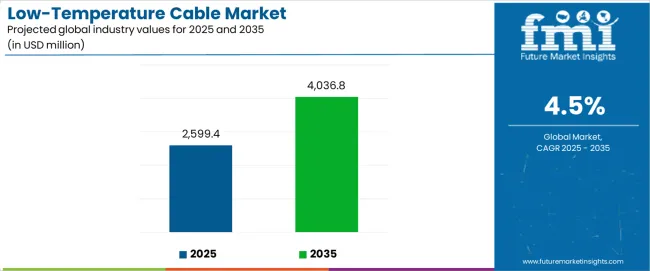
Between 2025 and 2030, the low-temperature cable market is projected to expand from USD 2,599.4 million to USD 3,239.4 million, resulting in a value increase of USD 640.0 million, which represents 44.5% of the total forecast growth for the decade. This phase of development will be shaped by increasing adoption of specialized cable technologies in aerospace applications, rising demand for enhanced insulation materials, and growing emphasis on reliable electrical systems with superior low-temperature performance characteristics. Industrial equipment manufacturers are expanding their cable requirements to address the growing demand for extreme environment applications, cryogenic systems, and specialized operational requirements.
| Metric | Value |
|---|---|
| Estimated Value in (2025E) | USD 2,599.4 million |
| Forecast Value in (2035F) | USD 4,036.8 million |
| Forecast CAGR (2025 to 2035) | 4.5% |
From 2030 to 2035, the low-temperature cable market is forecast to grow from USD 3,239.4 million to USD 4,036.8 million, adding another USD 797.4 million, which constitutes 55.5% of the overall ten-year expansion. This period is expected to be characterized by the expansion of advanced insulation technologies, the integration of enhanced conductor materials, and the development of multi-functional cable platforms with superior temperature resistance capabilities. The growing adoption of specialized industrial practices will drive demand for low-temperature cables with superior performance systems and compatibility with extreme environment operations across industrial applications.
Between 2020 and 2025, the low-temperature cable market experienced steady growth, driven by increasing demand for specialized electrical solutions and growing recognition of advanced cable technology as essential components for reliable operations across aerospace, industrial equipment, and energy systems applications. The low-temperature cable market developed as manufacturers recognized the potential for specialized cables to maintain electrical performance while ensuring operational reliability and enabling cost-effective installation protocols. Technological advancement in insulation materials and conductor design began emphasizing the critical importance of maintaining electrical integrity and performance consistency in extreme temperature environments.
Market expansion is being supported by the increasing global demand for specialized electrical solutions and the corresponding need for advanced cable systems that can provide superior electrical performance and reliability while enabling enhanced operational efficiency and safety across various industrial and aerospace applications. Modern industrial operations and electrical system specialists are increasingly focused on implementing cable technologies that can deliver consistent performance, prevent system failures, and provide reliable electrical connectivity throughout extreme temperature conditions and diverse operational environments. Low-temperature cables' proven ability to deliver exceptional electrical integrity against temperature extremes, enable time-efficient installations, and support cost-effective operational protocols make them essential components for contemporary industrial and aerospace operations.
The growing emphasis on industrial reliability and operational safety is driving demand for low-temperature cables that can support specialized application requirements, improve system performance outcomes, and enable automated electrical systems. Manufacturers' preference for technology that combines effective electrical performance with operational durability and environmental resistance is creating opportunities for innovative cable implementations. The rising influence of advanced industrial practices and specialized application requirements is also contributing to increased demand for low-temperature cables that can provide enhanced conductor performance, real-time operational capabilities, and reliable performance across extended operational periods.
The low-temperature cable market is poised for steady growth and technological advancement. As industries across aerospace, energy, transportation, and specialized manufacturing seek solutions that deliver exceptional electrical performance, operational reliability, and environmental resistance, low-temperature cables are gaining prominence not just as specialized components but as strategic enablers of modern industrial practices and critical system operations.
Rising specialized application adoption in Asia-Pacific and expanding industrial modernization initiatives globally amplify demand, while manufacturers are leveraging innovations in insulation technology systems, conductor materials, and integrated performance technologies.
Pathways like advanced insulation cable platforms, specialized conductor systems, and multi-application cable solutions promise strong margin uplift, especially in aerospace and energy segments. Geographic expansion and technology integration will capture volume, particularly where local industrial practices and specialized application adoption are critical. Regulatory support around industrial safety, electrical performance requirements, and operational reliability standards give structural support.
The low-temperature cable market is segmented by product type, application, voltage rating, end-use sector, and region. By product type, the market is divided into single-core low-temperature cable, multi-core low-temperature cable, and shielded low-temperature cable categories. By application, it covers industrial, medical, energy, transportation, and aerospace. By voltage rating, the low-temperature cable market includes low voltage (≤1kV), medium voltage (1kV-35kV), and high voltage (>35kV) systems. By end-use sector, it is categorized into manufacturing industries, healthcare facilities, energy companies, and transportation operators. Regionally, the low-temperature cable market is divided into North America, Europe, East Asia, South Asia & Pacific, Latin America, and the Middle East & Africa.
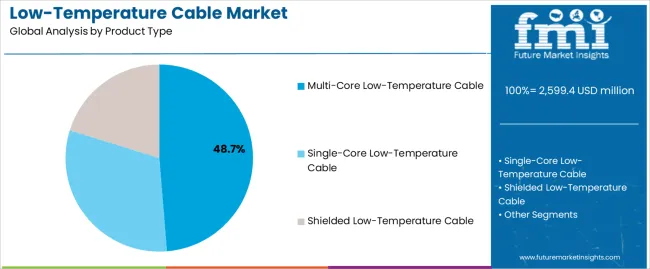
The multi-core low-temperature cable segment is projected to account for 48.7% of the low-temperature cable market in 2025, reaffirming its position as the leading product category. Industrial operations and specialized system integrators increasingly utilize multi-core low-temperature cables for their superior connectivity capabilities when operating across complex electrical installations, excellent space efficiency characteristics, and cost-effectiveness in applications ranging from industrial automation to aerospace system integration. Multi-core low-temperature cable technology's advanced conductor configuration capabilities and integrated insulation systems directly address the industrial requirements for comprehensive electrical connectivity in extreme temperature environments.
This product segment forms the foundation of modern specialized electrical installations, as it represents the cable type with the greatest operational versatility and established market demand across multiple application categories and industrial sectors. Manufacturer investments in enhanced insulation technologies and automated manufacturing compatibility continue to strengthen adoption among electrical contractors and industrial enterprises. With companies prioritizing installation efficiency and system optimization, multi-core low-temperature cables align with both performance requirements and economic efficiency objectives, making them the central component of comprehensive electrical system strategies.
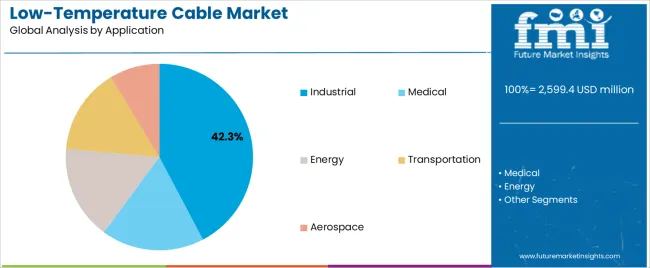
Industrial applications are projected to represent 42.3% of low-temperature cable demand in 2025, underscoring their critical role as the primary consumers of specialized cable technology for equipment connectivity, process control, and industrial automation applications. Industrial operators prefer low-temperature cables for their exceptional electrical performance capabilities, reliability characteristics, and ability to maintain electrical integrity while ensuring effective system operation throughout diverse industrial environments. Positioned as essential components for modern industrial operations, low-temperature cables offer both performance advantages and operational safety benefits.
The segment is supported by continuous innovation in insulation technologies and the growing availability of specialized cable systems that enable enhanced electrical performance with superior temperature resistance and rapid installation capabilities. Additionally, industrial operators are investing in comprehensive electrical infrastructure to support large-scale cable utilization and operational planning. As specialized industrial demand becomes more prevalent and system reliability requirements increase, industrial applications will continue to dominate the end-use market while supporting advanced electrical automation utilization and system integration strategies.
The low-temperature cable market is advancing steadily due to increasing demand for specialized electrical technologies and growing adoption of advanced cable solutions that provide superior electrical performance and operational reliability while enabling enhanced system efficiency across diverse industrial and aerospace applications. However, the low-temperature cable market faces challenges, including high material costs, specialized installation requirements, and the need for technical expertise and certification programs. Innovation in insulation technologies and conductor materials continues to influence product development and market expansion patterns.
The growing adoption of specialized insulation systems, advanced conductor materials, and enhanced cable design is enabling manufacturers to produce low-temperature cables with superior electrical performance, enhanced temperature resistance, and improved operational reliability functionalities. Advanced insulation systems provide improved electrical integrity while allowing more efficient installation and consistent performance across various industrial applications and operational conditions. Manufacturers are increasingly recognizing the competitive advantages of advanced cable technologies for product differentiation and premium market positioning.
Modern low-temperature cable producers are incorporating aerospace-grade materials, industrial-specific designs, and integrated performance monitoring systems to enhance operational capabilities, enable predictive maintenance functionalities, and deliver value-added solutions to industrial customers. These technologies improve system reliability while enabling new operational capabilities, including enhanced electrical performance, temperature monitoring integration, and reduced operational overhead. Advanced system integration also allows manufacturers to support comprehensive electrical infrastructure and industrial modernization beyond traditional cable applications.
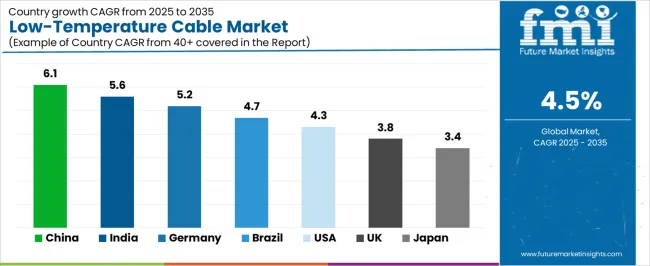
| Country | CAGR (2025-2035) |
|---|---|
| China | 6.1% |
| India | 5.6% |
| Germany | 5.2% |
| Brazil | 4.7% |
| USA | 4.3% |
| UK | 3.8% |
| Japan | 3.4% |
The low-temperature cable market is experiencing steady growth globally, with China leading at a 6.1% CAGR through 2035, driven by the expanding industrial modernization programs, growing specialized manufacturing adoption, and significant investment in advanced electrical infrastructure development. India follows at 5.6%, supported by government initiatives promoting industrial technology, increasing manufacturing expansion demand, and growing electrical system requirements.
Germany shows growth at 5.2%, emphasizing advanced industrial innovation and specialized electrical technology development. Brazil records 4.7%, focusing on industrial expansion and manufacturing modernization. The USA demonstrates 4.3% growth, prioritizing electrical system standards and industrial automation excellence. The UK exhibits 3.8% growth, emphasizing electrical technology adoption and specialized industrial development. Japan shows 3.4% growth, supported by high-tech manufacturing initiatives and specialized electrical system concentration.
The report covers an in-depth analysis of 40+ countries; seven top-performing countries are highlighted below.
Revenue from low-temperature cables in China is projected to exhibit strong growth with a CAGR of 6.1% through 2035, driven by expanding industrial modernization programs and rapidly growing specialized manufacturing adoption supported by government initiatives promoting electrical infrastructure development. The country's strong position in cable manufacturing and increasing investment in advanced industrial systems are creating substantial demand for specialized low-temperature cable solutions. Major industrial enterprises and manufacturing facilities are establishing comprehensive electrical infrastructure capabilities to serve both domestic industrial demand and specialized application markets.
Revenue from low-temperature cables in India is expanding at a CAGR of 5.6%, supported by the country's growing industrial sector, expanding government support for manufacturing modernization, and increasing adoption of specialized electrical solutions. The country's initiatives promoting industrial technology and growing manufacturer awareness are driving requirements for advanced electrical connectivity capabilities. International suppliers and domestic manufacturers are establishing extensive production and service capabilities to address the growing demand for low-temperature cable products.
Revenue from low-temperature cables in Germany is expanding at a CAGR of 5.2%, supported by the country's advanced industrial capabilities, strong emphasis on electrical technology innovation, and robust demand for high-performance electrical systems in manufacturing and aerospace applications. The nation's mature industrial sector and efficiency-focused operations are driving sophisticated low-temperature cable systems throughout the industrial sector. Leading manufacturers and technology providers are investing extensively in advanced materials and specialized electrical technologies to serve both domestic and international markets.
Revenue from low-temperature cables in Brazil is growing at a CAGR of 4.7%, driven by the country's expanding industrial sector, growing manufacturing operations, and increasing investment in electrical infrastructure development. Brazil's industrial expansion and commitment to manufacturing modernization are supporting demand for specialized low-temperature cable solutions across multiple industrial segments. Manufacturers are establishing comprehensive service capabilities to serve the growing domestic market and industrial development opportunities.
Revenue from low-temperature cables in the USA is expanding at a CAGR of 4.3%, supported by the country's advanced electrical technology sector, strategic focus on industrial efficiency, and established specialized manufacturing capabilities. The USA's industrial innovation leadership and technology integration are driving demand for low-temperature cables in manufacturing, aerospace, and specialized industrial applications. Manufacturers are investing in comprehensive technology development to serve both domestic industrial markets and international specialized applications.
Revenue from low-temperature cables in the UK is growing at a CAGR of 3.8%, driven by the country's focus on industrial technology advancement, emphasis on manufacturing efficiency, and strong position in specialized electrical development. The UK's established industrial innovation capabilities and commitment to manufacturing modernization are supporting investment in advanced cable technologies throughout major industrial regions. Industry leaders are establishing comprehensive technology integration systems to serve domestic manufacturing operations and specialized industrial applications.
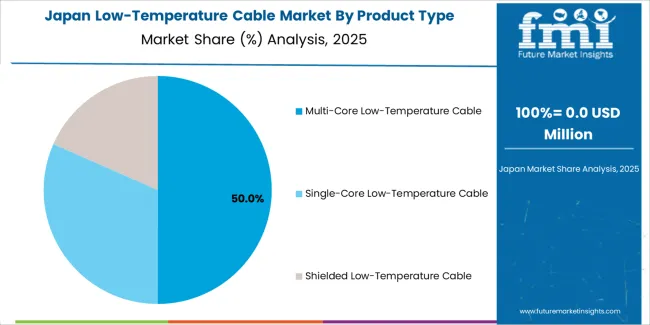
Revenue from low-temperature cables in Japan is expanding at a CAGR of 3.4%, supported by the country's high-tech manufacturing initiatives, growing specialized industrial sector, and strategic emphasis on electrical system development. Japan's advanced technology capabilities and integrated industrial systems are driving demand for specialized low-temperature cables in precision manufacturing, aerospace, and high-value industrial applications. Leading manufacturers are investing in specialized capabilities to serve the stringent requirements of high-tech manufacturing and specialized industrial industries.
The low-temperature cable market in Europe is projected to grow from USD 546.8 million in 2025 to USD 849.6 million by 2035, registering a CAGR of 4.5% over the forecast period. Germany is expected to maintain its leadership position with a 38.4% market share in 2025, declining slightly to 37.9% by 2035, supported by its strong industrial sector, advanced electrical technology capabilities, and comprehensive manufacturing industry serving diverse low-temperature cable applications across Europe.
France follows with a 16.2% share in 2025, projected to reach 16.8% by 2035, driven by robust demand for low-temperature cables in aerospace manufacturing, industrial modernization programs, and specialized electrical applications, combined with established electrical technology infrastructure and industrial expertise. The United Kingdom holds a 14.9% share in 2025, expected to reach 15.1% by 2035, supported by strong industrial technology sector and growing specialized manufacturing activities.
Italy commands a 11.8% share in 2025, projected to reach 12.2% by 2035, while Spain accounts for 8.7% in 2025, expected to reach 9.0% by 2035. The Netherlands maintains a 5.3% share in 2025, growing to 5.5% by 2035. The Rest of Europe region, including Nordic countries, Eastern Europe, Belgium, Poland, and other nations, is anticipated to maintain momentum, with its collective share moving from 4.7% to 3.5% by 2035, attributed to increasing industrial modernization in Eastern Europe and growing specialized manufacturing penetration in Nordic countries implementing advanced electrical technology programs.
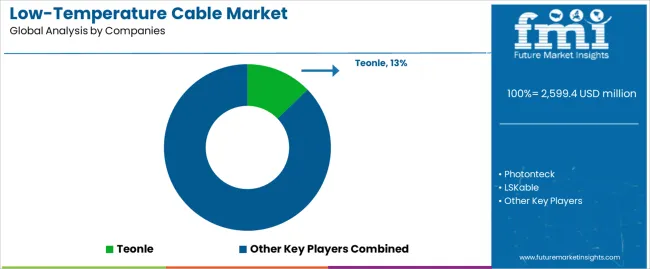
The low-temperature cable market is characterized by competition among established cable manufacturers, specialized electrical technology producers, and integrated electrical solutions providers. Companies are investing in insulation technology research, conductor material optimization, cable design development, and comprehensive product portfolios to deliver consistent, high-performance, and application-specific low-temperature cable solutions. Innovation in advanced materials, electrical performance enhancement, and operational reliability improvement is central to strengthening market position and competitive advantage.
Teonle leads the low-temperature cable market with a strong market share, offering comprehensive low-temperature cable solutions including advanced insulation systems with a focus on industrial and aerospace applications. Photonteck provides specialized electrical cable capabilities with an emphasis on advanced conductor technologies and automated manufacturing systems. LSKable delivers innovative electrical products with a focus on high-performance platforms and commercial industrial services. Amphenol TPC specializes in electrical connectivity and low-temperature cable technologies for specialized industrial applications. IMCAVI focuses on specialized electrical equipment and integrated cable solutions. CORNING offers advanced cable platforms with emphasis on high-performance electrical and specialized applications.
| Items | Values |
|---|---|
| Quantitative Units (2025) | USD 2,599.4 million |
| Product Type | single-Core Low-Temperature Cable, Multi-Core Low-Temperature Cable, Shielded Low-Temperature Cable |
| Application | Industrial, Medical, Energy, Transportation, Aerospace |
| Voltage Rating | Low Voltage (≤1kV), Medium Voltage (1kV-35kV), High Voltage (>35kV) |
| End-Use Sector | Manufacturing Industries, Healthcare Facilities, Energy Companies, Transportation Operators |
| Regions Covered | North America, Europe, East Asia, South Asia & Pacific, Latin America, Middle East & Africa |
| Countries Covered | China, India, Germany, Brazil, United States, United Kingdom, Japan and 40+ countries |
| Key Companies Profiled | Teonle, Photonteck, LSKable, Amphenol TPC, IMCAVI, and CORNING |
| Additional Attributes | Dollar sales by product type and application category, regional demand trends, competitive landscape, technological advancements in insulation systems, conductor material development, electrical performance innovation, and industrial application integration |
The global low-temperature cable market is estimated to be valued at USD 2,599.4 million in 2025.
The market size for the low-temperature cable market is projected to reach USD 4,036.8 million by 2035.
The low-temperature cable market is expected to grow at a 4.5% CAGR between 2025 and 2035.
The key product types in low-temperature cable market are multi-core low-temperature cable, single-core low-temperature cable and shielded low-temperature cable.
In terms of application, industrial segment to command 42.3% share in the low-temperature cable market in 2025.






Our Research Products

The "Full Research Suite" delivers actionable market intel, deep dives on markets or technologies, so clients act faster, cut risk, and unlock growth.

The Leaderboard benchmarks and ranks top vendors, classifying them as Established Leaders, Leading Challengers, or Disruptors & Challengers.

Locates where complements amplify value and substitutes erode it, forecasting net impact by horizon

We deliver granular, decision-grade intel: market sizing, 5-year forecasts, pricing, adoption, usage, revenue, and operational KPIs—plus competitor tracking, regulation, and value chains—across 60 countries broadly.

Spot the shifts before they hit your P&L. We track inflection points, adoption curves, pricing moves, and ecosystem plays to show where demand is heading, why it is changing, and what to do next across high-growth markets and disruptive tech

Real-time reads of user behavior. We track shifting priorities, perceptions of today’s and next-gen services, and provider experience, then pace how fast tech moves from trial to adoption, blending buyer, consumer, and channel inputs with social signals (#WhySwitch, #UX).

Partner with our analyst team to build a custom report designed around your business priorities. From analysing market trends to assessing competitors or crafting bespoke datasets, we tailor insights to your needs.
Supplier Intelligence
Discovery & Profiling
Capacity & Footprint
Performance & Risk
Compliance & Governance
Commercial Readiness
Who Supplies Whom
Scorecards & Shortlists
Playbooks & Docs
Category Intelligence
Definition & Scope
Demand & Use Cases
Cost Drivers
Market Structure
Supply Chain Map
Trade & Policy
Operating Norms
Deliverables
Buyer Intelligence
Account Basics
Spend & Scope
Procurement Model
Vendor Requirements
Terms & Policies
Entry Strategy
Pain Points & Triggers
Outputs
Pricing Analysis
Benchmarks
Trends
Should-Cost
Indexation
Landed Cost
Commercial Terms
Deliverables
Brand Analysis
Positioning & Value Prop
Share & Presence
Customer Evidence
Go-to-Market
Digital & Reputation
Compliance & Trust
KPIs & Gaps
Outputs
Full Research Suite comprises of:
Market outlook & trends analysis
Interviews & case studies
Strategic recommendations
Vendor profiles & capabilities analysis
5-year forecasts
8 regions and 60+ country-level data splits
Market segment data splits
12 months of continuous data updates
DELIVERED AS:
PDF EXCEL ONLINE
Cable Line Fault Indicator Market Size and Share Forecast Outlook 2025 to 2035
Cable Tray Market Size and Share Forecast Outlook 2025 to 2035
Cable Granulator Market Size and Share Forecast Outlook 2025 to 2035
Cable Distribution Cabinets Market Size and Share Forecast Outlook 2025 to 2035
Cable Accessories Market Growth - Trends & Forecast 2025 to 2035
Cable Cleaning Solutions Market Analysis - Size, Share, and Forecast Outlook 2025 to 2035
Cable Cleaning Equipment Market Analysis - Size, Share, and Forecast Outlook 2025 to 2035
Cable Material Market Growth - Trends & Forecast 2025 to 2035
Cable Fault Locator Market Size, Share, and Forecast 2025 to 2035
Cable Connectors and Adapters Market Analysis by Application, Product, Type and Region: Forecast from 2025 to 2035
Cable Cars and Ropeways Market Growth - Trends & Forecast 2025 to 2035
Cable Wrapping Tape Market
Cable Racks Market
Cable Testing Market
Cable Assemblies Market
Cable Carrier Market
Cable Detector Market
Cable Flange Market
LED Cable Market
HVDC Cables Market Size and Share Forecast Outlook 2025 to 2035

Thank you!
You will receive an email from our Business Development Manager. Please be sure to check your SPAM/JUNK folder too.
Chat With
MaRIA